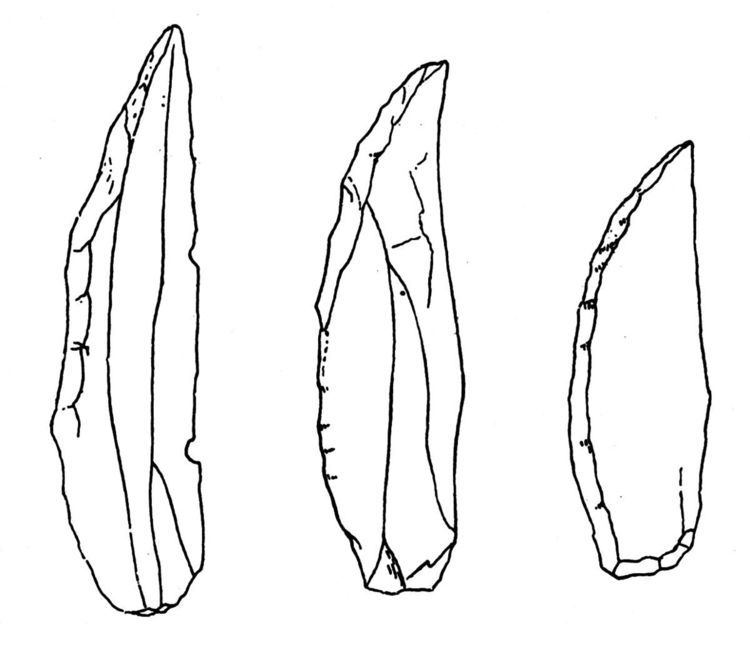Dates 41,030 – 39,260 cal BP | ||
 | ||
Châtelperronian was the earliest industry of the Upper Palaeolithic in central and south western France, extending also into Northern Spain. It derives its name from the site of la Grotte des Fées, in Châtelperron, Allier, France.
Contents
- Important sites and lithic production and associations
- Dispute over disruption of the site
- In popular culture
- References
It arose from the earlier Mousterian industry. It lasted from between c. 45,000 and c. 40,000 BP. The industry produced denticulate stone tools and also a distinctive flint knife with a single cutting edge and a blunt, curved back. The use of ivory at Châtelperronian sites tends to be more frequent than that of the later Aurignacian, while antler tools appear to be absent.
It was followed by the Aurignacian industry. Controversy exists as to how far archaeologically it is associated with Neanderthal people. The Châtelperronian industry may relate to the origins of the very similar Gravettian culture. French archaeologists have traditionally classified both cultures together under the name Périgordian, Early Perigordian being equivalent to Châtelperronian and all the other phases corresponding to Gravettian, though this scheme is not often used by Anglophone authors.
Important sites and lithic production and associations
Large thick flakes/small blocks were used for cores, and were prepared with a crest over a long smooth surface. Using one or two striking points, long thin blades were detached. Direct percussion with a soft hammer was likely used for accuracy. Thicker blades made in this process were often converted into side scrapers, burins were often created in the same manner from debitage as well.
The manner of production is a solid continuation of the Mousterian but the ivory adornments found in association seem to be a more clear connection to Aurignacian peoples, who are often argued to be the earliest introduction of H. sapiens sapiens into Europe. The technological refinement of the Châtelperronian and neighbouring Uluzzian in Central-Southern Italy is often argued to be the product of cultural influence from H. sapiens sapiens that lived nearby, but these predate both the Aurignacian and the earliest presence of H. sapiens sapiens in Europe.
Dispute over disruption of the site
João Zilhão and colleagues argue that the findings are complicated by disturbance of the site in the 19th century, and conclude that the apparent pattern of Aurignacian/Châtelperronian inter-stratification is an artifact of disturbance. · Bordes and Teyssandier (2011) further support this assertion. They claim post-depositional processes are behind the inter-stratification of Chatelperronian and Aurignacian material, a claim they back up by citing numerous open-air Chatelperronian sites without any evidence of Middle-Paleolithic layers below.Paul Mellars and colleagues have criticized Zilhão et al.'s analysis, and argue that the original excavation by Delporte was not affected by disturbance.
Paul Mellars, however, now has concluded on the basis of new radiocarbon dating on the cave of Grotte du Renne "that there was strong possibility—if not probability— that they were stratigraphically intrusive into the Châtelperronian deposits from .. overlying Proto-Aurignacian levels" and that "The central and inescapable implication of the new dating results from the Grotte du Renne is that the single most impressive and hitherto widely cited pillar of evidence for the presence of complex “symbolic” behavior among the late Neanderthal populations in Europe has now effectively collapsed." More recent research led by Jean-Jacques Hublin of the Max Planck Institute for Evolutionary Anthropology in Leipzig, Germany shows using new new high precision dates that Châtelperronian tools were produced by neanderthals. In Sept 2016, researchers using a proteinomic approach to the fossils have determined conclusive that Châtelperronian tools were produced by neanderthals.
In popular culture
Author Jared Diamond argues in his 1991 non-fiction book, The Third Chimpanzee, that Châtelperron may represent a community of Neanderthals who had to some extent adopted the culture of the modern Homo sapiens that had established themselves in the surrounding area, which would account for the signs of a hybrid culture found at the site. Diamond compares these hypothetical Neanderthal hold-outs to more recent Native Americans in North and South America who adopted European technologies such as firearms or domestication of horses in order to survive in an environment dominated by technologically more-advanced competitors.
The fifth book of Jean Auel's Earth's Children series, The Shelters of Stone, 2002, and the sixth book The Land of the Painted Caves 2010 are set in this region of modern-day France, during this period.
